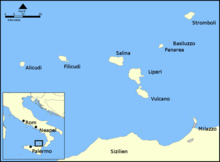Capo Graziano
The Capo Graziano is a cape in the southeast of the island of Filicudi , the archipelago of the Aeolian Islands heard in the Tyrrhenian Sea off the north coast of Sicily lie. On a terrace on the slope of the "Montagnola", an elevation of the cape, the remains of a Bronze Age village are preserved. The cape or the settlement of the same name gave its name to the Bronze Age Capo Graziano culture (approx. 2200–1430 BC) which was widespread throughout the Aeolian Islands .
Cliff steps lead uphill to the archaeological site of Capo Graziano. The plateau (a natural terrace) extends at a height of about 100 m on the steep slope of the 174-meter-high Montagnola with the "Villaggio Preistorico", a naturally very well protected settlement on the land side of Capo Graziano, with the remains of over 20 round ones or oval huts. A few more huts were discovered on the same slope at about 140 meters. The settlement is considered to be historically valuable. It probably originated towards the end of the first phase of the Capo Graziano culture (approx. 2200–1700 BC), i.e. before 1700 BC. At two points of the flat isthmus that connects Cape Graziano with Filicudi, remains of previous settlements from phase I of the Capo Graziano culture were discovered, which were built near the port but poorly protected: Casa Lopez and Filo Braccio. The abandonment of less protected settlements in favor of new settlements in naturally very well fortified places is characteristic of the transition from the first to the second main phase of the said culture and can also be observed on other Aeolian Islands. In the case of the settlement of Capo Graziano, several - not always easy to distinguish - settlement phases could be identified, on the basis of renewed floors or new huts built over older ones. The most recent finds come from the Milazzese culture (approx. 1430–1270 BC).
While Filicudi appears today as a rough island with little drinking water, the conditions in the Bronze Age were more favorable, so that agriculture as well as cattle breeding and fishing were possible on a larger scale. Traces point to terracing of slopes in order to make them more agriculturally usable. In addition, the island offered good pastureland at that time.
The archaeological materials found indicate relationships with the Aegean region. There are two ceramic levels of the Capo Graziano culture: In the older one, the ceramic has smooth surfaces with incised linear motifs. According to Luigi Bernabò Brea, the shapes are based on prototypes from the early Helladic phase III and from the beginning of the Middle Helladic phase in Greece. Younger ceramics are often decorated with incised wavy lines, triangles and rosettes made of impressed points. Examples of older ceramics were found in the oldest phase of the settlement - as well as in the two preceding settlements at the port mentioned above - while ceramics exclusively of the younger stage appear in the following layers. With its associated fragments imported are not rare Mycenaean pottery of the time scales Late Helladic I and II. Vessels of Capo Graziano culture were also used as grave goods found in natural crevices on the slopes of Montagnola and the harbor. The last settlement phase of Capo Graziano is characterized by the Milazzese culture, which has very close connections to the Thapsos culture of Sicily. In this phase most of the existing huts were still used and only the floors were renewed; only three new huts, similar to the previous ones, were built. The settlement was eventually destroyed by fire during the Milazzese period.
literature
- Luigi Bernabò Brea , Madeleine Cavalier: Meligunìs Lipàra Vol VI. Filicudi. Insediamenti dell'età del bronzo. , Academia die Scienze, Palermo 1991.
Web links
- description
- Finds in the Museo Archeologico di Lipari (ital.)
- Map ( Memento from March 24, 2013 in the Internet Archive )
Coordinates: 38 ° 33 ′ 25.7 " N , 14 ° 35 ′ 27.2" E
Individual evidence
- ↑ Reinhard Jung: ΧΡΟΝΟΛΟΓΙΑ COMPARATA. Comparative chronology of southern Greece and southern Italy from approx. 1700/1600 to 1000 BC Vienna 2006, pp. 76-78, which derives this from the older excavation publications and stratigraphic information.
- ↑ Some information, also on the time of the two previous settlements at Gianmarco Alberti, e.g. B. in: A Bayesian 14C chronology of Early and Middle Bronze Age in Sicily. Toward to Independent Absolute dating. In: Journal of Archaeological Science 40 (2013) pp. 2502-2514, especially pp. 2504ff.
- ^ Robert Leighton: Sicily Before History. An Archaeological Survey from the Palaeolithic to the Iron Age. Cornell University Press, Ithaca - New York 1999, p. 133. - ISBN 9780801485855 .
- ↑ Detailed analyzes of the Mycenaean ceramics by Capo Graziano with Reinhard Jung: ΧΡΟΝΟΛΟΓΙΑ COMPARATA. Comparative chronology of southern Greece and southern Italy from approx. 1700/1600 to 1000 BCE Vienna 2006, pp. 76–83.
- ↑ Reinhard Jung: ΧΡΟΝΟΛΟΓΙΑ COMPARATA. Comparative chronology of southern Greece and southern Italy from approx. 1700/1600 to 1000 BCE Vienna 2006, p. 81.

